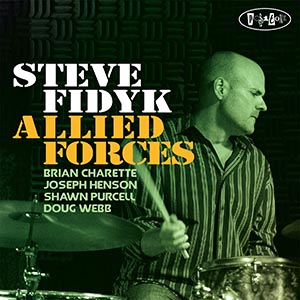 When I state that Steve Fidyk wrote the book on big band drumming, I’m not being totally honest because he’s written many such books….
When I state that Steve Fidyk wrote the book on big band drumming, I’m not being totally honest because he’s written many such books….
S. Victor Aaron – Something Else reviews
 When I state that Steve Fidyk wrote the book on big band drumming, I’m not being totally honest because he’s written many such books….
When I state that Steve Fidyk wrote the book on big band drumming, I’m not being totally honest because he’s written many such books….
S. Victor Aaron – Something Else reviews
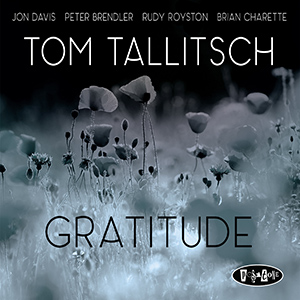 Last spring tenor sax ace Tom Tallitsch put forth his seventh album Gratitude, comprising mostly of songs gestated during a particularly reflective time in his life, a roughly yearlong span during which he lost his father and became one himself. Tallitsch has never been known as someone who composed or played without earnest emotion, so the extra motivation put his personal investment this time on another level…. S. Victor Aaron – Something Else Reviews
Last spring tenor sax ace Tom Tallitsch put forth his seventh album Gratitude, comprising mostly of songs gestated during a particularly reflective time in his life, a roughly yearlong span during which he lost his father and became one himself. Tallitsch has never been known as someone who composed or played without earnest emotion, so the extra motivation put his personal investment this time on another level…. S. Victor Aaron – Something Else Reviews
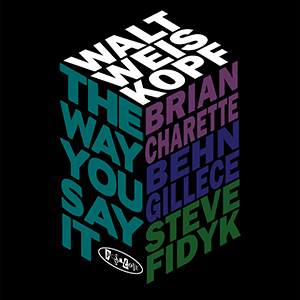 One of the musical highlights in a Wisconsin summer full of them is the scheduled appearance of Steely Dan and Steve Winwood at the BMO Harris Pavilion in Milwaukee on July 16th.
One of the musical highlights in a Wisconsin summer full of them is the scheduled appearance of Steely Dan and Steve Winwood at the BMO Harris Pavilion in Milwaukee on July 16th.
The Inquisition suspects that there are many upsides to being Donald Fagen and Walter Becker; one is that after four decades of critical acclaim and multi-platinum albums including Grammy Best Album-winning “Two Against Nature,” the duo is positioned to record and tour with their choice of the best players in the world.
Exhibit A is tenor saxophonist Walt Weiskopf, whose new album, “The Way You Say It,” is receiving outstanding reviews.
Fox Cities jazz aficionados may recall Weiskopf from his outstanding contributions to former Big Band Reunion leader and Lawrence University professor Bob Levy’s breakthrough album, “Crossover,” on Stellar Sound Productions that also included John Harmon, Janet Planet, Tom Washatka, Dane Richeson, Ken Schaphorst and Matt Turner. Weiskopf played on four cuts and contributed his own original composition, “Southwest Blues.”
“Walt is a great player who has been influenced by all the great ones,” Levy said. “It was a real kick playing with him. He’s very easy-going and very giving. There is no ego with Walt. He’s got a lot of confidence but without ego.”
Weiskopf and his tenor sax will take the stage with Steely Dan in Milwaukee. His technical prowess and his team-play mindset have made him an excellent addition to the band for the last 15 years.
“In 2002 I got a call for horn section dates for (Steely Dan’s album) “Everything Must Go” and subsequently was called to play on the title tune,” Weiskopf recalls. “The following January, Walter (Becker) called me and asked me to tour with the band that year and of course I said I would be thrilled to do it. Since the ’03 tour, we’ve toured in ’06, ’07, ’08, ’09, ’11, ’13, ’14, and ’15 as well as this year. In 2010 and ’12, I toured with The Dukes of September; a band led by Donald with Boz Scaggs and Michael McDonald.”
He was also a key contributor to Fagen’s solo albums, “Morph The Cat,” and “Sunken Condos.”
“I love being a part of a great band and Steely Dan is certainly all of that,” Weiskopf said. “Playing with this band since 2003 has been a great pleasure and continues to be a hugely artistic, gratifying and creative challenge.”
Weiskopf has sixteen albums of his own to his credit; “The Way You Say It” is his third release for Posi-Tone Records, following the critically-acclaimed “Overdrive” (2014) and “Open Road” (2015). Its twelve cuts include nine Weiskopf originals including the title tune. It features organist Brian Charette, Behn Gillece playing vibraphone and drummer Steve Fidyk, all of whom are beneficiaries of Weiskopf’s generosity and respond with inspired playing and solos that are superb complements to his virtuosity and command of his instrument.
The title composition is the closing track on the album. Gillece sets the stage for some of Weiskopf’s most heart-felt and melodic playing augmented by Charette’s understated support. Weiskopf did not have to go very far for inspiration.
“The Way You Say It,” is dedicated to my wife, Marcie,” he said. “She has the most pleasing, inviting, tuneful speaking voice I’ve ever heard and it always reminds that it’s not what you play, it’s how you play it and it’s not what you say, it’s the way that you say it.”
The album opens with Weiskopf’s “Coffee and Scones,” an up-tempo valentine to “two of my favorite things,” that showcases each musician’s talents in solos that are energetic and melodic, but never forced and fit easily into the groove. The subject matter is not just inspirational but practical.
“I like a dark roast red eye and a blueberry scone – the blueberry gives me the illusion that I am eating healthy – followed by 90 minutes of practicing my horn on a caffeine high.”
Another Weiskopf original “Separation,” follows, and the composer bookends Charette’s precise yet beautifully understated solo with some of his best and most inventive playing.
“For me personally, being on the road apart from the one you love for long periods of time is the most challenging thing about being a musician,” Weiskopf said. “I am so lucky the beautiful woman I married understands my career as a musician.”
On the flip side, Weiskopf’s musical wanderings have taken him to some fabulous places.
“Inntoene, is a tip-of-the-hat to one of the best international jazz festivals anywhere,” he said. “I can’t wait to get back to the beautiful town of Diersbach, Austria, and play with these great musicians.”
The band blends seamlessly at the outset of “Dreamlining,” an examination of “the best kind of dreaming – floating effortlessly and swinging from the clouds – the kind of dream that you wish would last longer than it usually does” before Weiskopf steps out and explores the lower registers of his tenor and Charette eases into yet another ear-pleasing solo.
Weiskopf’s technical mastery is off and running with both speed and precision on “Blues Combination,” inspired by John Coltrane’s “Locomotion.” Intrigued by Ray Charles’s take on the tune, Weiskopf grooves effortlessly on “Candy.”
“I’ve wanted to try this one for years and finally worked up my nerve,” Weiskopf said. “It was nice to have the beauty of Brian’s organ to lean on throughout this one. A quick, down and dirty vision in D minor. ‘Envisioned’ follows. I love hearing Behn bang those bars on the shout chorus. When Charette solos, you can almost see his fingers flying up and down the keyboard.”
Homesickness for the cloudy skies of Syracuse, NY, inspired “Invisible Sun,” which is followed by “Manny Boy.”
“Never would I have believed a year ago that I could feel so much love for a dog,” Weiskopf said. “A year ago, Marcie and I rescued Manny. He has shown me a whole new side of myself.”
Weiskopf et al serve up creative takes on Weather Report’s “Scarlett Woman,” and Charlie Parker’s “Segment,” before concluding with “The Way You Say It.”
“Segment, is the currently the Charlie Parker tune that I am most obsessed with and I hope Bird would’ve have understood my compulsion to modulate up a half-step,” he said. “I love Weather Report and ‘Scarlett Woman’ in particular. It turned out to be a great vehicle for Steve to showcase his grooviness.”
George Halas – SCENE
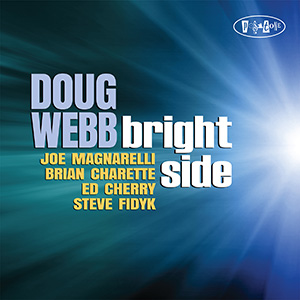 From the very first, sweet strains of tenor saxophone that leap from my CD player, I know it’s Doug Webb. I’ve been listening to his style and enjoying the excitement he creates on stage for three decades. Webb has been featured on over 150 jazz recordings and has added his blues soaked style to tracks used in hundreds of television programs and movies. He’s an on-demand, Southern California, saxophone session man for television and film. This, his seventh album release, is funk-based with Manarelli on trumpet blending well with Webb’s saxophone licks. Webb has penned seven out of the twelve songs on this CD. His composition skills showcase smooth technique and a love of melody. The addition of Charette on organ spices things up and thickens the stew when Webb puts the pots on to boil. This is particularly obvious on cut #3, “The Drive”, where everyone of the musicians seem powered up and propel their improvisational skills at a fast clip. I found Webb’s composition, “Melody for Margie” to be beautiful, promoting a visceral emotion. Another of his compositions I enjoyed immensely is “One For Hank” where Cherry on guitar gers to stretch out, as well as Charette on organ. All in all, this CD swings and Webb is flying above the solid rhythm section, as daring as a man on a trapeze. His music is exciting.
From the very first, sweet strains of tenor saxophone that leap from my CD player, I know it’s Doug Webb. I’ve been listening to his style and enjoying the excitement he creates on stage for three decades. Webb has been featured on over 150 jazz recordings and has added his blues soaked style to tracks used in hundreds of television programs and movies. He’s an on-demand, Southern California, saxophone session man for television and film. This, his seventh album release, is funk-based with Manarelli on trumpet blending well with Webb’s saxophone licks. Webb has penned seven out of the twelve songs on this CD. His composition skills showcase smooth technique and a love of melody. The addition of Charette on organ spices things up and thickens the stew when Webb puts the pots on to boil. This is particularly obvious on cut #3, “The Drive”, where everyone of the musicians seem powered up and propel their improvisational skills at a fast clip. I found Webb’s composition, “Melody for Margie” to be beautiful, promoting a visceral emotion. Another of his compositions I enjoyed immensely is “One For Hank” where Cherry on guitar gers to stretch out, as well as Charette on organ. All in all, this CD swings and Webb is flying above the solid rhythm section, as daring as a man on a trapeze. His music is exciting.
Dee Dee McNeil – musicalmemoirs’s blog
 Straight ahead swinging jazz powered by a crew of leaders in their own rights, drummer Fidyk makes no statements here other than he can keep things on track from the back of the stage and that good are meant to be shared by all. Not the kind of feel good jazz you’d associate with water front bars on summer nights but you have to call it that for lack of a better name, this is smoking stuff that works throughout and is the kind of friendly hard core jazz that brings new listeners into the tent despite themselves. On the money throughout and totally hot.
Straight ahead swinging jazz powered by a crew of leaders in their own rights, drummer Fidyk makes no statements here other than he can keep things on track from the back of the stage and that good are meant to be shared by all. Not the kind of feel good jazz you’d associate with water front bars on summer nights but you have to call it that for lack of a better name, this is smoking stuff that works throughout and is the kind of friendly hard core jazz that brings new listeners into the tent despite themselves. On the money throughout and totally hot.
Chris Spector – Midwest Record
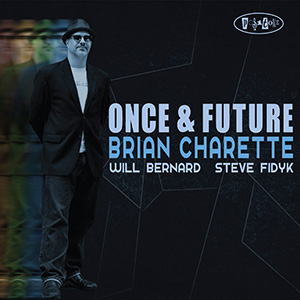 While unboxing guitarist Will Bernard’s delightful latest offering Out & About a few months ago, it was impossible not to rave on the key contributions of his combo’s organist Brian Charette. Charette has regularly put in stellar supporting roles whether it’s for Posi-Tone Records stablemates like Bernard or any jazz leader of note in need of some maximal Hammond B3.
While unboxing guitarist Will Bernard’s delightful latest offering Out & About a few months ago, it was impossible not to rave on the key contributions of his combo’s organist Brian Charette. Charette has regularly put in stellar supporting roles whether it’s for Posi-Tone Records stablemates like Bernard or any jazz leader of note in need of some maximal Hammond B3.
Once & Future (Posi-Tone, June 3, 2016) doesn’t reach for such levels of risk-taking but it does offer the occasion of hearing Charette again trading licks with Bernard, only with the leader/sideman roles reversed. No horns this time as Charette’s group is reduced to the tried-and-true organ/guitar trio (Steve Fidyk brings the drums). As a noted educator of the B3 (he writes instructional books and articles, conducts masterclasses and teaches at workshops), Once & Future can be thought of as a ‘clinic’ record where he touches on many of the various techniques of the jazz organ as well as many shades of sub-styles, from Jimmy Smith to Larry Young. In keeping, only three of these fourteen tunes are his and many of the rest might be familiar to you. They may also titillate with Charette’s manner by which he carries these songs…
S. Victor Aaron – Something Else Reviews
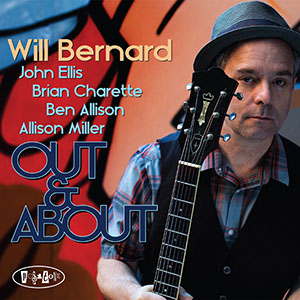 As if more proof was necessary Out & About confirms guitarist Will Bernard is as skilled a bandleader as he is an instrumentalist. And both roles require an artful approach as this album makes clear: it’s one thing to find talented musicians-as Bernard most certainly does here-it’s quite another to elicit that talent in such a way it complements the talent (and personality) of each of the other musicians involved.
As if more proof was necessary Out & About confirms guitarist Will Bernard is as skilled a bandleader as he is an instrumentalist. And both roles require an artful approach as this album makes clear: it’s one thing to find talented musicians-as Bernard most certainly does here-it’s quite another to elicit that talent in such a way it complements the talent (and personality) of each of the other musicians involved.
In this context then Out & About is a most ambitious undertaking because Bernard enlists the assistance of three other formidable musicians: drummer Allison Miller, bassist Ben Allison and saxophonist John Ellis, all with their own careers and ensembles of some note and history (and based on that reality alone, some measurable and presumably healthy ego). But the San Francisco Bay Area guitarist also demonstrates the wisdom to preserve his relationship with long-time trio partner, organist Brian Charette, who acts as a combination catalyst and bonding agent unifying this quintet for the sake of the recording.
The five-some lightheartedly dance through “Happy Belated,” illustrating the easy going interactions of which they’re capable, then spend a little less than two minutes illustrating the grace and delicacy they can create on “Not too Fancy.” And, as “Next Guest” attests, it hardly matters who’s soloing here at any give time because, even as Bernard fingers his fret board with such precision here, Allison is almost equally so on bass, never colliding with the guitarist, but acting as a counterpoint as if to highlight the leader’s skill.
The album’s longest track at 6:45, “Habanera” features Charette drawing out the melody line in an altogether luxurious pace, but that doesn’t obscure the motion of Miller at her kit: her playing is so natural, it’s vivid enough to visualize. Meanwhile, Bernard leads by example, he using sufficiently varied tones and attacks to keep himself and all involved alert in a state of positive flux. Accordingly, Ellis twists and turns playing his horn on “Redwood (Business Casual)” where everyone is quick on the uptake of each other’s ideas. The leader unwinds more fluid lines on “Pan Seared,” and the keyboardist instinctively follows suit.
All of which such interplay is especially admirable given the economy of arrangement and production (by Marc Free from one day of recording in Brooklyn) within cuts in the three-to-five minute duration range. But then what better way to illustrate the versatility of a band than for it to move quick through the various changes Bernard presents in this all-original material. His understated vigor in this musicianship on the title song and “Homebody” insinuates the sounds within the listener’ Out & About will not recede into mere background music.
Doug Collette – All About Jazz
 The title of Doug Webb’s seventh Positone release sums up not only a personal outlook on his vocation, but the reality of it as well, given a career involving 30+ years as a professional musician. Bright Side teams the tenorist with some of the brightest of his immediate peers on the imprint with trumpeter Joe Magnarelli, organist Brian Charette and guitarist Ed Cherry each successful leaders in their own right. Drummer Steve Fidyk doesn’t have a session under his auspices yet, but his calendar as a sideman remains packed with cherry-picked gigs.
The title of Doug Webb’s seventh Positone release sums up not only a personal outlook on his vocation, but the reality of it as well, given a career involving 30+ years as a professional musician. Bright Side teams the tenorist with some of the brightest of his immediate peers on the imprint with trumpeter Joe Magnarelli, organist Brian Charette and guitarist Ed Cherry each successful leaders in their own right. Drummer Steve Fidyk doesn’t have a session under his auspices yet, but his calendar as a sideman remains packed with cherry-picked gigs.
As with earlier Webb dates the program draws liberally from a songbook of originals while threading in a handful of covers including the bossa nova “Bahia” and Oliver Nelson’s hardbop workhorse “The Drive”. Webb is a specialist at devising tight punchy heads that pack sizeable ensemble wallops while working flexibly as spring boards for economy-minded solos. “Society Al”, a titular riff on a Dexter Gordon composition, features his horn initially in isolation before the band arrives to advance a rolling, organ-forward groove.
“Silver Lining” gives Charette the chance to show off his skill with building swirling, descending textures as Fidyk carves out a choppy beat beside him. Magnarelli sits out leaving Webb to ride the waves through a solo ripe with both velocity and spirited inflections. Credited to someone with the surname Eastlee, “Steak Sauce” shows off the quintet’s shared facility with a boogaloo rhythm. Charette’s bass lines ooze grease and the horns lock on some lean, but tasty unisons atop another porous series of patterns from Fidyk. Cherry leans back and concerns himself with comping inventively under the frontline extemporizations before moving stepping out for a supple say of his own.
“Melody for Margie” and “One for Hank” reference more important figures in Webb’s personal history, the first at a ballad tempo that capitalize on Charette and Cherry’s capabilities at shaping amorous support lines and Fidyk’s gentle facility with brushes. The second personifies in sound a saxophonist answering to the surname Mobley, at least in general feel, as Webb glides through a set of cerulean-hued changes and into another plush-voiced solo that ranges purposefully through his horn’s middle register. Charette and Cherry also get spotlights before a group exit and the album caps off with another groove workout in the accommodating guise of Webb’s “Funky Medina”. With friends and continued opportunities like these it’s easy to see how he entertains his abiding optimism.
Derek Taylor – Dusted Magazine
 Tenor saxophonist Tom Tallitsch is an Illinois-bred,
Tenor saxophonist Tom Tallitsch is an Illinois-bred,
New Jersey-based bandleader and Gratitude is his
seventh album a leader. Tallitsch plays Straightahead
postbop, tossing a few Curve balls to keep things
interesting. He is Of the generation(s) Of players that
doesn’t rely on the Great American Songbook for
material (9 Of the 11 tracks herein are Originals) and he
dips into the rock world for inspiration.
The album opens with “Terrain”, a surging, modal
midtempo tune evoking ’70s McCoy Tyner. Tallitsch
has a notable tone—burly approach of Rollins,
flow of Dexter Gordon and cool of Lester Young, etc.—
but no one influence dominates in a fascinating blend
Of robustness and yearning. Drummer Rudy Royston
kicks up as much dust (and propulsion) as Art Blakey and Jon Davis’ piano is spare, slightly percussive (that
Tyner influence) and possessed of an easy lyricism, He and Tallitsch share a very measured approach. taking
an almost leisurely tack in constructing their solos. Fleetwood Mac’s “Gold Dust Woman” might not
seem the kind Of fare a jazz combo might tackle, but Tallitsch shows its majesty. The saxophonist invests
some elegant blues feeling into the proceedings while Davis, Royston and bassist Peter Brendler slyly add a
soul-jazz groove more implied than overt and guest Brian Charette deftly adds slightly gothic-sounding
organ. These lads close out the program with another seemingly unlikely tune, Led Zeppelin’s “Thank You”,
essayed with a gospel feel thanks to organ (especially) and Davis’ sparse, Slightly Thelonious Monk-like
Chords. Tallitsch gets to shine in a poignant manner without ever getting Cloying Or going Over the top.
Gratitude is an album that displays a rare and very engaging balance Of fervor and restraint, expressive
ace musicianship and terseness.
by Mark Keresman – New York City Jazz Record
 Walt Weiskopf wrote the book on jazz harmonics and improvisation…actually about ten of so books on those topics. But the best demonstration of his firm grasp on the building blocks for good jazz rests in his records, and his fifteenth one, The Way You Say It (April 8, 2016, Posi-Tone Records), is the latest chapter of his recorded book of work.
Walt Weiskopf wrote the book on jazz harmonics and improvisation…actually about ten of so books on those topics. But the best demonstration of his firm grasp on the building blocks for good jazz rests in his records, and his fifteenth one, The Way You Say It (April 8, 2016, Posi-Tone Records), is the latest chapter of his recorded book of work.
No matter how much Walt Weiskopf mixes things up for The Way You Say It, the craftsmanship shines through.
S. Victor Aaron – Something Else Reviews